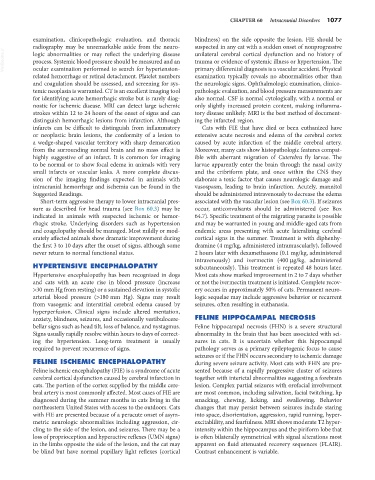Page 1105 - Small Animal Internal Medicine, 6th Edition
P. 1105
CHAPTER 60 Intracranial Disorders 1077
examination, clinicopathologic evaluation, and thoracic blindness) on the side opposite the lesion. FIE should be
radiography may be unremarkable aside from the neuro- suspected in any cat with a sudden onset of nonprogressive
VetBooks.ir logic abnormalities or may reflect the underlying disease unilateral cerebral cortical dysfunction and no history of
trauma or evidence of systemic illness or hypertension. The
process. Systemic blood pressure should be measured and an
ocular examination performed to search for hypertension-
examination typically reveals no abnormalities other than
related hemorrhage or retinal detachment. Platelet numbers primary differential diagnosis is a vascular accident. Physical
and coagulation should be assessed, and screening for sys- the neurologic signs. Ophthalmologic examination, clinico-
temic neoplasia is warranted. CT is an excellent imaging tool pathologic evaluation, and blood pressure measurements are
for identifying acute hemorrhagic stroke but is rarely diag- also normal. CSF is normal cytologically, with a normal or
nostic for ischemic disease. MRI can detect large ischemic only slightly increased protein content, making inflamma-
strokes within 12 to 24 hours of the onset of signs and can tory disease unlikely. MRI is the best method of document-
distinguish hemorrhagic lesions from infarction. Although ing the infarcted region.
infarcts can be difficult to distinguish from inflammatory Cats with FIE that have died or been euthanized have
or neoplastic brain lesions, the conformity of a lesion to extensive acute necrosis and edema of the cerebral cortex
a wedge-shaped vascular territory with sharp demarcation caused by acute infarction of the middle cerebral artery.
from the surrounding normal brain and no mass effect is Moreover, many cats show histopathologic features compat-
highly suggestive of an infarct. It is common for imaging ible with aberrant migration of Cuterebra fly larvae. The
to be normal or to show focal edema in animals with very larvae apparently enter the brain through the nasal cavity
small infarcts or vascular leaks. A more complete discus- and the cribriform plate, and once within the CNS they
sion of the imaging findings expected in animals with elaborate a toxic factor that causes neurologic damage and
intracranial hemorrhage and ischemia can be found in the vasospasm, leading to brain infarction. Acutely, mannitol
Suggested Readings. should be administered intravenously to decrease the edema
Short-term aggressive therapy to lower intracranial pres- associated with the vascular lesion (see Box 60.3). If seizures
sure as described for head trauma (see Box 60.3) may be occur, anticonvulsants should be administered (see Box
indicated in animals with suspected ischemic or hemor- 64.7). Specific treatment of the migrating parasite is possible
rhagic stroke. Underlying disorders such as hypertension and may be warranted in young and middle-aged cats from
and coagulopathy should be managed. Most mildly or mod- endemic areas presenting with acute lateralizing cerebral
erately affected animals show dramatic improvement during cortical signs in the summer. Treatment is with diphenhy-
the first 3 to 10 days after the onset of signs, although some dramine (4 mg/kg, administered intramuscularly), followed
never return to normal functional status. 2 hours later with dexamethasone (0.1 mg/kg, administered
intravenously) and ivermectin (400 µg/kg, administered
HYPERTENSIVE ENCEPHALOPATHY subcutaneously). This treatment is repeated 48 hours later.
Hypertensive encephalopathy has been recognized in dogs Most cats show marked improvement in 2 to 7 days whether
and cats with an acute rise in blood pressure (increase or not the ivermectin treatment is initiated. Complete recov-
>30 mm Hg from resting) or a sustained elevation in systolic ery occurs in approximately 50% of cats. Permanent neuro-
arterial blood pressure (>180 mm Hg). Signs may result logic sequelae may include aggressive behavior or recurrent
from vasogenic and interstitial cerebral edema caused by seizures, often resulting in euthanasia.
hyperperfusion. Clinical signs include altered mentation,
anxiety, blindness, seizures, and occasionally vestibulocere- FELINE HIPPOCAMPAL NECROSIS
bellar signs such as head tilt, loss of balance, and nystagmus. Feline hippocampal necrosis (FHN) is a severe structural
Signs usually rapidly resolve within hours to days of correct- abnormality in the brain that has been associated with sei-
ing the hypertension. Long-term treatment is usually zures in cats. It is uncertain whether this hippocampal
required to prevent recurrence of signs. pathology serves as a primary epileptogenic focus to cause
seizures or if the FHN occurs secondary to ischemic damage
FELINE ISCHEMIC ENCEPHALOPATHY during severe seizure activity. Most cats with FHN are pre-
Feline ischemic encephalopathy (FIE) is a syndrome of acute sented because of a rapidly progressive cluster of seizures
cerebral cortical dysfunction caused by cerebral infarction in together with interictal abnormalities suggesting a forebrain
cats. The portion of the cortex supplied by the middle cere- lesion. Complex partial seizures with orofacial involvement
bral artery is most commonly affected. Most cases of FIE are are most common, including salivation, facial twitching, lip
diagnosed during the summer months in cats living in the smacking, chewing, licking, and swallowing. Behavior
northeastern United States with access to the outdoors. Cats changes that may persist between seizures include staring
with FIE are presented because of a peracute onset of asym- into space, disorientation, aggression, rapid running, hyper-
metric neurologic abnormalities including aggression, cir- excitablility, and fearfulness. MRI shows moderate T2 hyper-
cling to the side of the lesion, and seizures. There may be a intensity within the hippocampus and the piriform lobe that
loss of proprioception and hyperactive reflexes (UMN signs) is often bilaterally symmetrical with signal alterations most
in the limbs opposite the side of the lesion, and the cat may apparent on fluid attenuated recovery sequences (FLAIR).
be blind but have normal pupillary light reflexes (cortical Contrast enhancement is variable.

